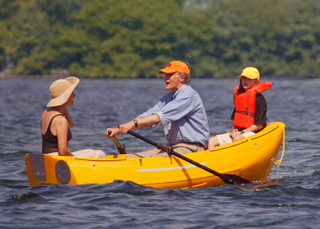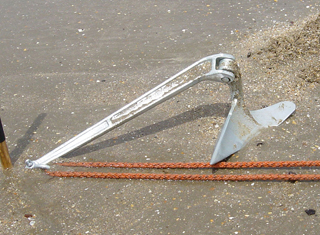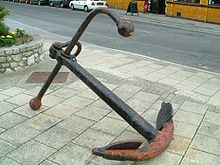All Adrift at Porthcurnick
 The other day, following his usual practice, as Colin walked down to the Lookout he scanned the bay to see what was going on. Doing this gives you an idea on what is about as you get a different perspective from the cliff path to that when inside the Lookout. It gives you a good idea on how busy it is, what nasties might await you and situations which might need watching as the Watch goes on. That day was school holidays, it was fine, the beach was busy and there were plenty of people in the water. Lying anchored close in to the Beach was a large motor cruiser, about 30ft long, and the family of five were busily climbing into their inflatable to go ashore. They looked to be in a hurry – perhaps late for lunch at the Hidden Hut?
The other day, following his usual practice, as Colin walked down to the Lookout he scanned the bay to see what was going on. Doing this gives you an idea on what is about as you get a different perspective from the cliff path to that when inside the Lookout. It gives you a good idea on how busy it is, what nasties might await you and situations which might need watching as the Watch goes on. That day was school holidays, it was fine, the beach was busy and there were plenty of people in the water. Lying anchored close in to the Beach was a large motor cruiser, about 30ft long, and the family of five were busily climbing into their inflatable to go ashore. They looked to be in a hurry – perhaps late for lunch at the Hidden Hut?
He reached the Lookout and took over from his predecessor, checking the books and taking a long sweep around the horizon with the large telescope. There were yachts about, the odd kayaker, but all seemed in order. Then something caught the corner of his eye in the right hand window. The motor cruiser was setting out to sea! Trouble was it was going stern first and there seemed to be no one onboard! The anchor chain hung uselessly over the bow, vibrating as the anchor bumped across the sea bed.
This was unusual and required further investigation. Turning his binoculars towards the beach he was in time to see a frantic man pushing his dinghy into the water, throwing himself after it, grabbing his oars. Then began a race to see if the man could row faster than his outgoing boat. By now this was clear of the headland with its rocks and away from other vessels so Colin was able to concentrate his attention on the man in the dinghy. It was clear he was no spring chicken, but adrenalin, embarrassment and fear can be mighty propellants. He was working his pars like a demon but, even then collapsed over his oars every few minutes to regain breath and resume the struggle. Colin’s main concern now was that he would have a heart attack!
 He did, however, reach his boat, to the relief of all those now witnessing the drama. A pause for breath, an engine re-start, and he was in control, moving back towards the bay. Unfortunately, in his haste, he had forgotten to raise the anchor which now dragged more heavily on the bottom., the chain grinding against the hull, steel against fibreglass – and there is only one winner to that happening. It did not make a hole but clearly his gel coat would be damaged and exhibited for all to see, further damaging his pride.
He did, however, reach his boat, to the relief of all those now witnessing the drama. A pause for breath, an engine re-start, and he was in control, moving back towards the bay. Unfortunately, in his haste, he had forgotten to raise the anchor which now dragged more heavily on the bottom., the chain grinding against the hull, steel against fibreglass – and there is only one winner to that happening. It did not make a hole but clearly his gel coat would be damaged and exhibited for all to see, further damaging his pride.
At last he got back to his starting point and re-anchored – hopefully paying out more chain. Jumping into his dinghy again, he picked up his oars, and set off back to the Hidden Hut, no doubt to finish his main course. But the poor man’s day was not yet over. Before he reached the beach the blade came off one of his oars, leaving him circling helplessly until he could manage to get near enough to regain the missing bits and paddle, Indian canoe style, back to the beach.
You could say this had been a bad day at the office for the skipper but never has the saying ‘ do things in haste, repent in leisure’ been better illustrated. So where did he go wrong? Well, you have to remember that all the anchor does in sand is grab a small toehold in the ground. It is not the anchor which mainly stops the boat from drifting but it is the chain. Chains are heavy, and, when you have laid out thirty feet or so the weight is far more than the anchor – and its weight which keeps the boat steady. Certainly a chain on its own will not stop a boat dragging, for that it needs the anchor, a hook to hold the chain in place. Your best illustration of this is to look at the anchor of a big ship. There it is, tucked up in its hawse pipe in the bow, and, compared to the bulk of the ship, it is minute. But when it anchors the ship will lay out several hundred yards of anchor cable. The anchor at the end hold the chain in place but it is the weight of the chain which hold the ship. For this reason the first thing to do if you find your anchor dragging is to lay out more chain.
It is also true, of course, that the more chain you have out the more is lying on the seabed creating friction or drag against the weight of the ship. The correct way to anchor any vessel is to work out roughly how deep the water is, let’s say ten feet and you then need at least thirty feet of cable, even better with fifty feet. You bring the boat to a stop and then, as it starts to drift back, drop the anchor and slowly pay out the cable. The idea is that it then lies lengthways along the seabed and not in an untidy heap on top of the anchor. When you reach the end of the cable you are putting out you wait a few moments to see of the boat stops. If it does then you motor gently astern, pulling the cable tight. Dragging the anchor backwards like this should put the flukes into the sea bed. If all is well, the boat will stop and the pull of the engine will counterbalanced by the anchor. All well – time to visit the Little Hut.
 Our friend in his haste just chucked the whole lot overboard and did not check to see if the anchor had set. He may not have put out enough chain, he may have dropped chain on top of anchor, fouling it and stopping it digging in. Sometimes the anchor set up consists of an anchor attached to about five fathoms (30ft) of chain and then a rope – easy to store on a small boat.. But it needs even more laid out as the rope does not have weight, it is distance from the anchor which makes it and the short chain lie flat on the bottom and hold the boat. Whatever the reason we must hope that he will learn from his experience and not make the same mistake again.
Our friend in his haste just chucked the whole lot overboard and did not check to see if the anchor had set. He may not have put out enough chain, he may have dropped chain on top of anchor, fouling it and stopping it digging in. Sometimes the anchor set up consists of an anchor attached to about five fathoms (30ft) of chain and then a rope – easy to store on a small boat.. But it needs even more laid out as the rope does not have weight, it is distance from the anchor which makes it and the short chain lie flat on the bottom and hold the boat. Whatever the reason we must hope that he will learn from his experience and not make the same mistake again.
Thistime there was no harm done but he could have lost his boat or, worse, given himself a heart attack.
Let’s not be too smug about this. Most of us have done it at some time in our sailing career. There is nothing more likely to focus the mind than to be sitting in your cabin after a hard day, gin and tonic in hand and see, out of the porthole, the boat which had been moored behind you move gently past, no sail, no engine and no one in the cockpit. Maybe you get up in the middle of the night and wonder why, when the tide has not change, the lights on the hotel on the shore which had been over the stern were now mysteriously visible over the bow. There but for the grace…………
So, no matter how careful or careless you are, things can always go wrong. That is the value of the Watchkeeper on the headland in the N.C.I. hut. Our man in the dinghy lieing back, collapsed and in trouble? Well, no doubt his family would have seen and raised the alarm but no one would have been quicker to do so, and to the right place, than our N.C.I. Watchkeeper. We need some more though so we can open every day during the summer. Give Robert a ring on 01872 501670 and find out what is involved.

